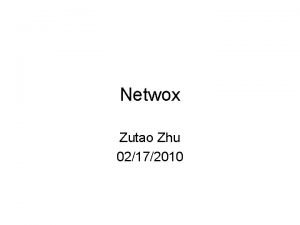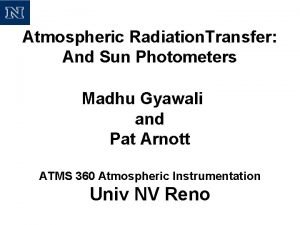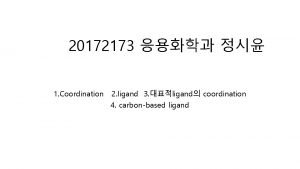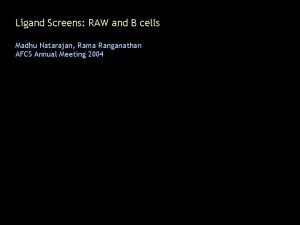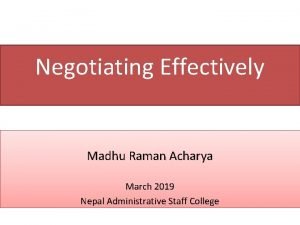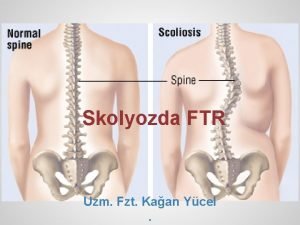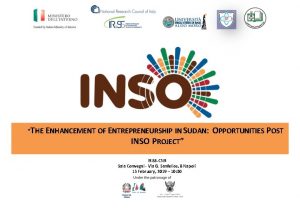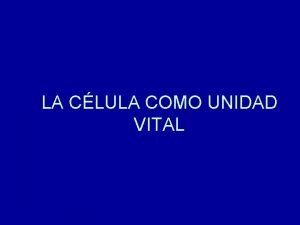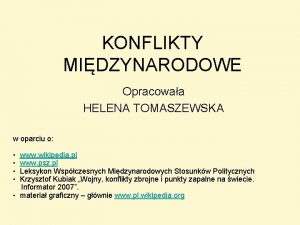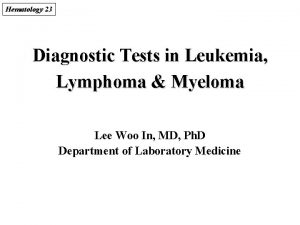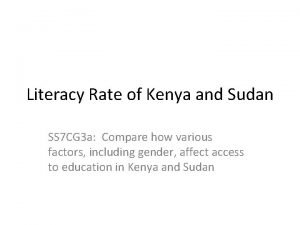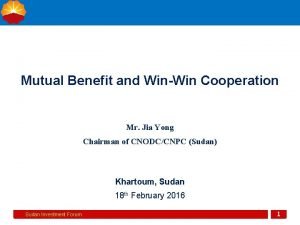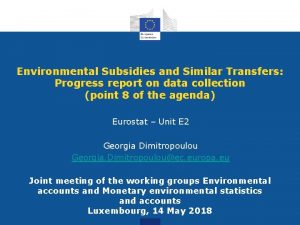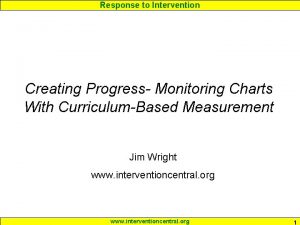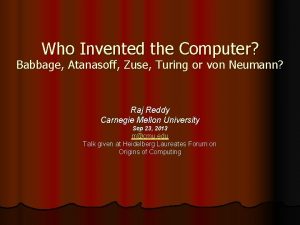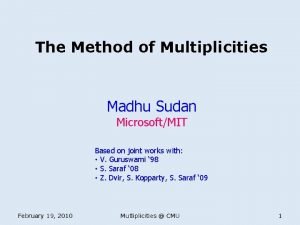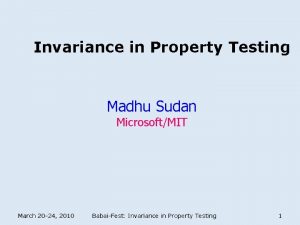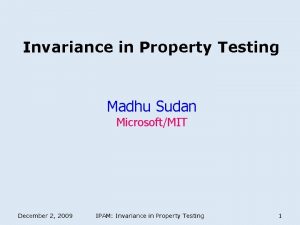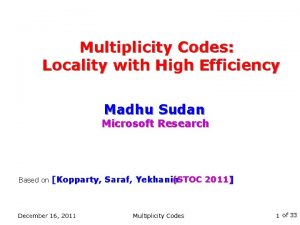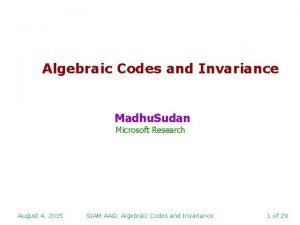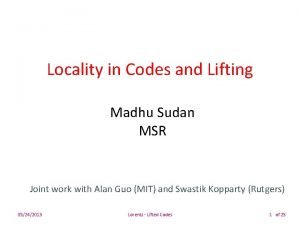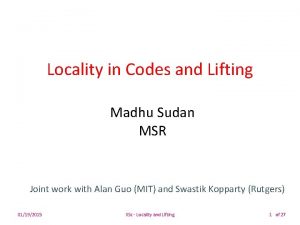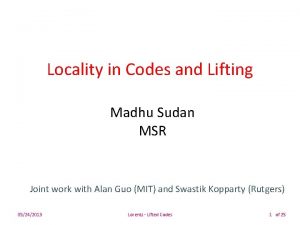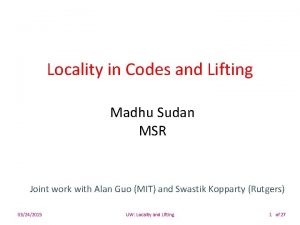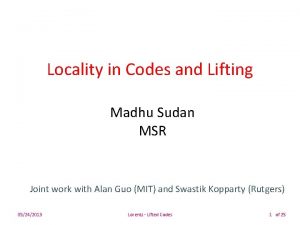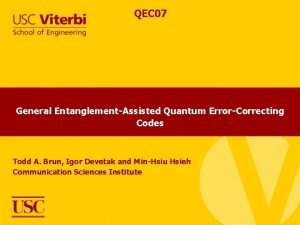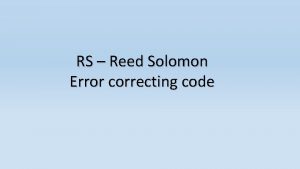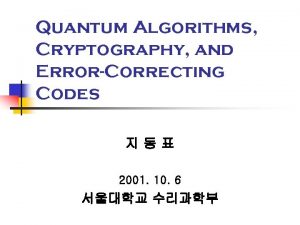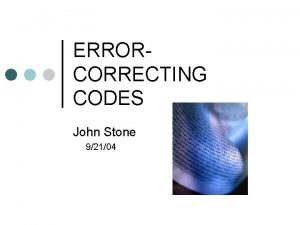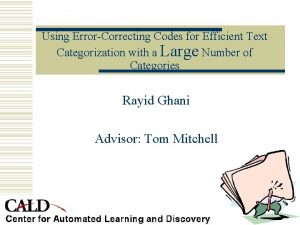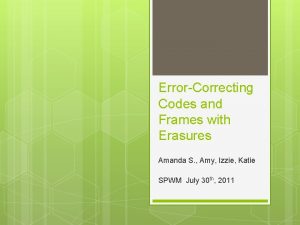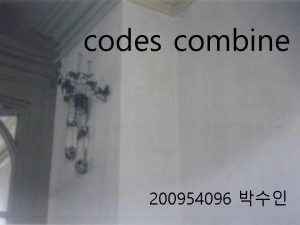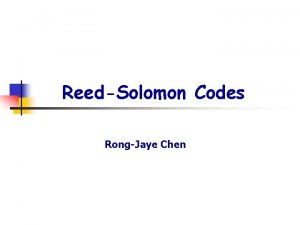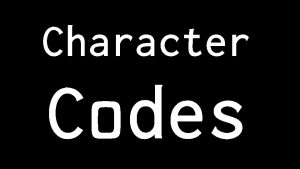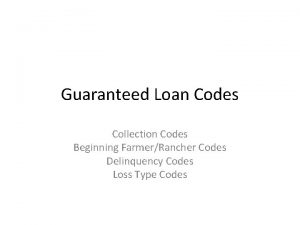ErrorCorrecting Codes Progress Challenges Madhu Sudan MicrosoftMIT 02172010


















![What is satisfaction? n n Articulated by [Luby, Mitzenmacher, Shokrollahi, Spielman ’ 96] Practically What is satisfaction? n n Articulated by [Luby, Mitzenmacher, Shokrollahi, Spielman ’ 96] Practically](https://slidetodoc.com/presentation_image_h2/a65d89887ca2bbfcbf9440412926d164/image-19.jpg)







![List-decoding: State of the art n n n [Zyablov-Pinsker/Blinovskii – late 80 s] n List-decoding: State of the art n n n [Zyablov-Pinsker/Blinovskii – late 80 s] n](https://slidetodoc.com/presentation_image_h2/a65d89887ca2bbfcbf9440412926d164/image-27.jpg)
![Algorithms for List-decoding n n n Not examined till ’ 88. First results: [Goldreich-Levin] Algorithms for List-decoding n n n Not examined till ’ 88. First results: [Goldreich-Levin]](https://slidetodoc.com/presentation_image_h2/a65d89887ca2bbfcbf9440412926d164/image-28.jpg)
![Results in List-decoding n q-ary case: n [Guruswami-Rudra ‘ 06] Codes of rate R Results in List-decoding n q-ary case: n [Guruswami-Rudra ‘ 06] Codes of rate R](https://slidetodoc.com/presentation_image_h2/a65d89887ca2bbfcbf9440412926d164/image-29.jpg)


- Slides: 31

Error-Correcting Codes: Progress & Challenges Madhu Sudan Microsoft/MIT 02/17/2010 ECC: Progress/Challenges (@CMU) 1

Communication in presence of noise We are now ready We are not ready Noisy Channel Sender Receiver If information is digital, reliability is critical 02/17/2010 ECC: Progress/Challenges (@CMU) 2

Shannon’s Model: Probabilistic Noise Sender Encode (expand) E: Σk Σn Receiver Noisy Channel Decode (compress? ) D: Σn Σk Probabilistic Noise: E. g. , every letter flipped to random other letter of Σ w. p. p Focus: Design good Encode/Decode algorithms. 02/17/2010 ECC: Progress/Challenges (@CMU) 3

Hamming Model: Worst-case error Errors: Upto t worst-case errors Focus: Code: C = Image(E) = {E(x) | x (Note: Not encoding/decoding) Є Σk } Goal: Design code to correct every possible pattern of t errors. 02/17/2010 ECC: Progress/Challenges (@CMU) 4

Problems in Coding Theory, Broadly n n Combinatorics: Design best possible errorcorrecting codes. Probability/Algorithms: Design algorithms correcting random/worst-case errors. 02/17/2010 ECC: Progress/Challenges (@CMU) 5

Part I (of III): Combinatorial Results 02/17/2010 ECC: Progress/Challenges (@CMU) 6

Hamming Notions Hamming Distance: ¢(x, y) = |{i | xi ≠ yi}| Distance of Code: ¢ (C) = minx, y 2 C {¢ (x, y)} Code of distance 2 t+1 corrects t errors. Main question: Four parameters: Length n, message length k, distance d, alphabet q = |Σ|. - How do they relate? - Want + n, " k, " d, ? q Let: R = k/n; δ= d/n; How do R, δ, q relate? 02/17/2010 ECC: Progress/Challenges (@CMU) 7

Simple results Ball(x, r) = {y in Σn | Δ(x, y) · r} Volume of Ball: Vol(q, n, r) = |Ball(x, r)| Entropy function: Hq(δ) = c s. t. Vol(q, n, δn) ¼ qcn Hamming (Packing) Bound: Balls of radius δn/2 around codewords are disjoint. R + Hq(δ/2) · 1 qk ¢ q. Hq(δ/2)n · qn 02/17/2010 ECC: Progress/Challenges (@CMU) 8

Simple results (contd. ) Gilbert-Varshamov (Greedy) Bound: Let C: Σk Σn be maximal code of distance d. Then balls of radius d-1 around codewords cover Σn So qk ¢ 02/17/2010 q. Hq(δn) n ¸q ……… Or … R ¸ 1 – Hq(δ) ECC: Progress/Challenges (@CMU) 9

Simple results (Summary) For the best code: 1 – H q( δ ) · R · 1 – Hq(δ/2) Which is right? After fifty years of research … We still don’t know. 02/17/2010 ECC: Progress/Challenges (@CMU) 10

Binary case (q =2): n Case of large distance: δ = ½ - ², ² 0. (² 2) · R · O* (² 2) GV/Cherno® n LP Bound Case of small (relative) distance: No bound better than R · 1 – (1 -o(1)) ¢ H(δ/2) Hamming n Case of constant distance d: (d/2) log n ¸ n-k ¸ 02/17/2010 BCH (1 -o(1)). ECC: Progress/Challenges (@CMU) (d/2) log n Hamming 11

Binary case (Closer look): n n n For general n, d: # Codewords ¸ 2 n / Vol (2, n, d-1) Can we do better? Twice as many codewords? (won’t change asymptotics of R, δ ) Recent progress [Jiang-Vardy]: # Codewords ¸ d ¢ 2 n / Vol(2, n, d-1) 02/17/2010 ECC: Progress/Challenges (@CMU) 12

Major questions in binary codes: n n n Give explicit construction meeting GV bound. n Specifically: Codes with δ = ½ - ² & R = (² 2) Is Hamming tight when δ 0 ? n Do there exist codes of distance δ with R = 1 – [ c ¢ (1 – o(1)) ¢ δ log 2 (1/δ) ] for c < 1? [Hamming: c > ½ ] Is LP Bound tight? 02/17/2010 ECC: Progress/Challenges (@CMU) 14

Combinatorics (contd. ): q-ary case n Fix δ and let q 1 (then fix q and let n 1) 1 – δ – O(1/log q) · R · GV bound n Surprising result (’ 80 s): n n Algebraic Geometry yields: 1 – δ – 1/q Plotkin R ¸ 1 – δ – 1/(√q – 1) (Also a negative surprise: BCH codes only yield 1 – R · (q-1)/q logq n) Not Hamming 02/17/2010 ECC: Progress/Challenges (@CMU) 15

Major questions: q-ary case n n n Suppose R = 1 – δ – f(q) What is the fastest decaying function f(. )? n (somewhere between 1/√q and 1/q). n Give a simple explanation for why f(q) · 1/√q Fix d, and let q 1 n How does (n-k)/(d logq n) grow in the limit? n Is it 1 or ½? Or somewhere in between? 02/17/2010 ECC: Progress/Challenges (@CMU) 16

Part II (of III): Correcting Random Errors 02/17/2010 ECC: Progress/Challenges (@CMU) 17

Recall Shannon ‘ 1948 n n Σ-symmetric channel w. error prob. p: n Transmits σ 2 Σ as σ w. p. 1 -p; and as ¿ 2 Σ- {σ} w. p. p/(q-1). Shannon’s Coding Theorem: n Can transmit at rate R = 1 – Hq(p) - ², 8 ² > 0 If R = 1 – Hq(p) - ², then for every n and k = Rn, there exist E: Σk Σn and D: Σn Σk s. t. Pr. Channel, x [D(Channel(E(x)) ≠ x] · exp(-n). n n Converse Coding Theorem: n Can not transmit at rate R = 1 – Hq(p) + ² So: No mysteries? 02/17/2010 ECC: Progress/Challenges (@CMU) 18

Constructive versions n n n Shannon’s functions: n E random, D brute force search. Can we get poly time E, D? n [Forney 66]: Yes! (Using Reed-Solomon codes correcting ²-fraction error + composition. ) n [Sipser-Spielman ‘ 92, Spielman ‘ 94, Barg. Zemor ‘ 97]: Even in linear time! Still didn’t satisfy practical needs. Why? n [Berrou et al. 92] Turbo codes + belief propagation: n No theorems; Much excitement 02/17/2010 ECC: Progress/Challenges (@CMU) 19
![What is satisfaction n n Articulated by Luby Mitzenmacher Shokrollahi Spielman 96 Practically What is satisfaction? n n Articulated by [Luby, Mitzenmacher, Shokrollahi, Spielman ’ 96] Practically](https://slidetodoc.com/presentation_image_h2/a65d89887ca2bbfcbf9440412926d164/image-19.jpg)
What is satisfaction? n n Articulated by [Luby, Mitzenmacher, Shokrollahi, Spielman ’ 96] Practically interesting question: n = 10000; q = 2, p =. 1; Desired error prob. = 10 -6; k = ? [Forney ‘ 66]: Decoding time: exp(1/(1 – H(p) – (k/n))); n Rate = 90% ) decoding time ¸ 2100; Right question: reduce decoding time to poly(n, 1/ ²); where ² = 1 – H(p) – (k/n) 02/17/2010 ECC: Progress/Challenges (@CMU) 20

Current state of the art n n Luby et al. : Propose study of codes based on irregular graphs (“Irregular LDPC Codes”). No theorems so far for erroneous channels. Strong analysis for (much) simpler case of erasure channels (symbols are erased); decoding time = O(n log (1/²)) (Easy to get “composition” based algorithms with decoding time = O(n poly(1/²)) Do have some proposals for errors as well (with analysis by Luby et al. , Richardson & Urbanke), but none known to converge to Shannon limit. 02/17/2010 ECC: Progress/Challenges (@CMU) 21

Part III: Correcting Adversarial Errors 02/17/2010 ECC: Progress/Challenges (@CMU) 22

Motivation: n n n As notions of communication/storage get more complex, modeling error as oblivious (to message/encoding/decoding) may be too simplistic. Need more general models of error + encoding/decoding for such models. Most pessimistic model: errors are worst-case. 02/17/2010 ECC: Progress/Challenges (@CMU) 23

Gap between worst-case & random errors n n n In Shannon model, with binary channel: n Can correct upto 50% (random) errors. ( 1 -1/q fraction errors, if channel q-ary. ) In Hamming model, for binary channel: n Code with more than n codewords has distance at most 50%. n So it corrects at most 25% worst-case errors. ( ½(1 – 1/q) errors in q-ary case. ) Shannon model corrects twice as many errors: n Need new approaches to bridge gap. 02/17/2010 ECC: Progress/Challenges (@CMU) 24

Approach: List-decoding n n n Main reason for gap between Shannon & Hamming: The insistence on uniquely recovering message. List-decoding: Relaxed notion of recovery from error. Decoder produces small list (of L) codewords, such that it includes message. Code is (p, L) list-decodable if it corrects p fraction error with lists of size L. 02/17/2010 ECC: Progress/Challenges (@CMU) 25

List-decoding n n n Main reason for gap between Shannon & Hamming: The insistence on uniquely recovering message. List-decoding [Elias ’ 57, Wozencraft ’ 58]: Relaxed notion of recovery from error. Decoder produces small list (of L) codewords, such that it includes message. Code is (p, L) list-decodable if it corrects p fraction error with lists of size L. 02/17/2010 ECC: Progress/Challenges (@CMU) 26

What to do with list? n n n Probabilistic error: List has size one w. p. nearly 1 General channel: Need side information of only O(log n) bits to disambiguate [Guruswami ’ 03] n (Alt’ly if sender and receiver share O(log n) bits, then they can disambiguate [Langberg ’ 04]). Computationally bounded error: n Model introduced by [Lipton, Ding Gopalan L. ] n List-decoding results can be extended (assuming PKI and some memory at sender) [Micali et al. ] 02/17/2010 ECC: Progress/Challenges (@CMU) 27
![Listdecoding State of the art n n n ZyablovPinskerBlinovskii late 80 s n List-decoding: State of the art n n n [Zyablov-Pinsker/Blinovskii – late 80 s] n](https://slidetodoc.com/presentation_image_h2/a65d89887ca2bbfcbf9440412926d164/image-27.jpg)
List-decoding: State of the art n n n [Zyablov-Pinsker/Blinovskii – late 80 s] n There exist codes of rate 1 – Hq(p) - epsilon that are (p, O(1))-list-decodable. Matches Shannon’s converse perfectly! (So can’t do better even for random error!) But [ZP/B] non-constructive! 02/17/2010 ECC: Progress/Challenges (@CMU) 28
![Algorithms for Listdecoding n n n Not examined till 88 First results GoldreichLevin Algorithms for List-decoding n n n Not examined till ’ 88. First results: [Goldreich-Levin]](https://slidetodoc.com/presentation_image_h2/a65d89887ca2bbfcbf9440412926d164/image-28.jpg)
Algorithms for List-decoding n n n Not examined till ’ 88. First results: [Goldreich-Levin] for “Hadamard’’ codes (non-trivial in their setting). More recent work: n [S. ’ 96, Shokrollahi-Wasserman ’ 98, Guruswami-S. ’ 99, Parvaresh-Vardy ’ 05, Guruswami-Rudra ’ 06] – Decode algebraic codes. n [Guruswami-Indyk ’ 00 -’ 02] theoretic codes. 02/17/2010 – Decode graph- ECC: Progress/Challenges (@CMU) 29
![Results in Listdecoding n qary case n GuruswamiRudra 06 Codes of rate R Results in List-decoding n q-ary case: n [Guruswami-Rudra ‘ 06] Codes of rate R](https://slidetodoc.com/presentation_image_h2/a65d89887ca2bbfcbf9440412926d164/image-29.jpg)
Results in List-decoding n q-ary case: n [Guruswami-Rudra ‘ 06] Codes of rate R correcting 1 – R - ² fraction errors with q = q(²) n Matches Shannon bound (except for q( ²) ) 9 Codes of rate ²c correcting 1 ¡ ² fraction errors. 2 ¡ c = 4: Guruswami et al. 2000 ¡ c ! 3: Implied by Parvaresh-Vardy 05 ¡ c = 3: Guruswami Rudra 02/17/2010 ECC: Progress/Challenges (@CMU) 30

Major open question ² Construct (p; O(1)) list-decodable binary code of rate 1 ¡ H(p) ¡ ² with polytime list decoding. . ² Note: If running time is poly(1=²) then this implies a solution to the random error problem as well. 02/17/2010 ECC: Progress/Challenges (@CMU) 34

Conclusions n n n Coding theory: Very practically motivated problems; solutions influence (if not directly alter) practice. Many mysteries remain in combinatorial setting. Significant progress in algorithmic setting, but many more questions to resolve. 02/17/2010 ECC: Progress/Challenges (@CMU) 35
 Color 02172010
Color 02172010 Color 02172010
Color 02172010 Physical progress and financial progress
Physical progress and financial progress Madhu gyawali
Madhu gyawali Justice for madhu
Justice for madhu 뭉
뭉 Madhu natarajan
Madhu natarajan Radpac model
Radpac model Sudan çıkma egzersizi
Sudan çıkma egzersizi Ambulasyon egzersizleri
Ambulasyon egzersizleri Karanlık gecede kara sudan zap suyuna giden yol
Karanlık gecede kara sudan zap suyuna giden yol In sudan
In sudan Inso south sudan
Inso south sudan Myeloperoxidase staining
Myeloperoxidase staining Sudan iii indicator biomolecules
Sudan iii indicator biomolecules Sudanese electricity distribution company
Sudanese electricity distribution company Macromolecules in food
Macromolecules in food Organizacion celular
Organizacion celular Bec curriculum in the philippines
Bec curriculum in the philippines National audit chamber sudan
National audit chamber sudan Jugosławia
Jugosławia Pas reaction principle
Pas reaction principle Aseeda sudan
Aseeda sudan Sudan black
Sudan black Sudan literacy rate
Sudan literacy rate Winwin south sudan
Winwin south sudan Cpi
Cpi Environmental progress
Environmental progress Progress monitoring charts
Progress monitoring charts Status progress report
Status progress report Progress babbage programmable computer
Progress babbage programmable computer Pupil progress meetings
Pupil progress meetings

